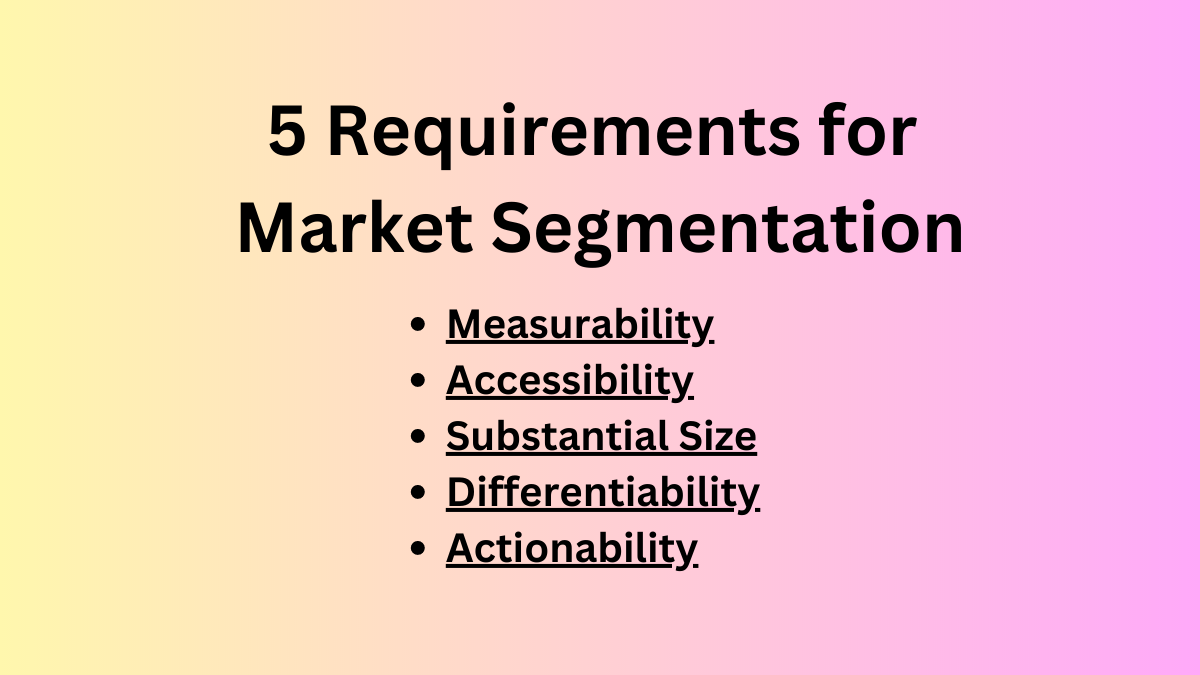Requirements For Segmentation
Market segmentation is the approach of dividing a larger market into smaller and manageable markets – called market segments. But, do you know these market segments need to fulfill five requirements?
In this article, we will explore these five requirements for effective market segmentation which include – measurability, accessibility, substantial size, differentiability, and actionability. Let’s explain them and why they are necessary to fulfill.
Measurability
Think of measurability as having a measuring tape for your market. It’s crucial because, in market segmentation, you need to quantify and understand the people in your target groups.
If you can’t measure them, it’s like trying to bake a cake without knowing the ingredients – your efforts won’t yield good results. For instance, selling ice cream becomes tricky if you don’t know which flavors your customers prefer. Measuring helps you identify those preferences accurately.
Accessibility
Accessibility is like having a map to reach your destination. It’s essential because you must be able to connect with the people in your segmented groups.
Imagine you have exciting news about a new video game. You need to know if your gamers are playing on Xbox, PlayStation, or PC. If you can’t reach them where they play, your message won’t get through. So, ensuring accessibility ensures your message lands where your customers are.
Read More: 15 Examples of Market Segmentation
Substantial Size
Substantial size is about having a big enough slice of the pie. It matters because your market segments should be sizable enough to make your efforts worthwhile.
Picture yourself running a lemonade stand. If only two people want lemonade on your street, it’s not worth squeezing all those lemons. But if there are twenty thirsty folks, it’s worth the effort. You want your market segments to be like that bigger crowd – worth your time and resources.
Read More: Industrial Products
Differentiability
Differentiability is akin to knowing the difference between night and day. It’s essential in market segments because it’s crucial to understand that different groups have distinct preferences.
Treating them all the same is like trying to sell snow to penguins – it won’t work. You need to recognize how each group is unique, just like night and day, and respond to their specific needs accordingly.
Actionability
Actionability is like having the right ingredients for a recipe. It’s vital because, in market segmentation, you need to be capable of satisfying each group’s needs. Think of it as having a recipe to bake cookies. If you have all the necessary ingredients and an oven, you can bake those delicious cookies.
But if you lack the ingredients or the oven, the recipe is useless. Similarly, you must ensure you have what it takes to meet the needs of each segment effectively. Otherwise, your efforts will fall flat.
Read More: Fast Moving Consumer Goods (FMCG)
Putting It All Together with Examples
Let’s say you have a new brand of sneakers, and you want to sell them. Here’s how these requirements of segmentation help:
- Measurability: You realize that sneaker lovers come in different sizes and styles. You measure this by collecting data on shoe sizes, colors, and styles that people buy. This helps you create sneakers that fit your customers perfectly.
- Accessibility: You find out that many sneaker fans hang out at sports events and on social media. So, you decide to advertise at games and use social media to reach them where they are most accessible.
- Substantial Size: You notice that young adults in their 20s and 30s make up a huge portion of sneaker buyers. It’s a big enough group to focus on, unlike a tiny niche group.
- Differentiability: You realize that some sneaker buyers want flashy, bright colors, while others prefer simple, classic designs. You make sure to offer both, so you cater to both tastes.
- Actionability: You have the resources and ability to produce and market sneakers in various sizes, styles, and colors. You can actually make and sell the sneakers you’ve designed based on your segments.
Read More: A List of 50 Fast-Moving Consumer Goods
Tips For Choosing the Right Market Segment
Further, here are the 5 tips following which you can choose the right market segment:
Understand Your Product
Before picking a market segment, know what your product offers. If you sell skateboards, they might not be a hit with elderly folks. Matching your product with the right segment is like serving ice cream on a hot day – it just makes sense.
Research Customer Needs
Dive into what your potential customers want. If you find that many people are looking for eco-friendly options, and your product fits the bill, you’ve struck gold. It’s like offering water to a thirsty traveler – they’ll appreciate it.
Read More: Unsought Products
Analyze Competition
Look at what others are doing. If every pizza place in town is offering spicy toppings, consider introducing milder options. Standing out from the crowd is like wearing a unique hat at a party – you’ll catch everyone’s attention.
Check Segment Viability
Make sure the segment you choose is substantial. If you’re selling beachwear, targeting people in snowy regions might not work. It’s like setting up a lemonade stand where people are craving hot cocoa – not the best match.
Test and Adjust
Don’t be afraid to experiment. If you initially target college students but find that young professionals are more interested, adjust your approach. It’s like trying on different shoes – you’ll find the ones that fit just right.
Read Next: The 4 Cs of Marketing
Arti Kushmi holds a BBS (Bachelor in Business Studies) degree and shares her business and marketing knowledge through this website. While not writing she will be reading and enjoying the moment.
